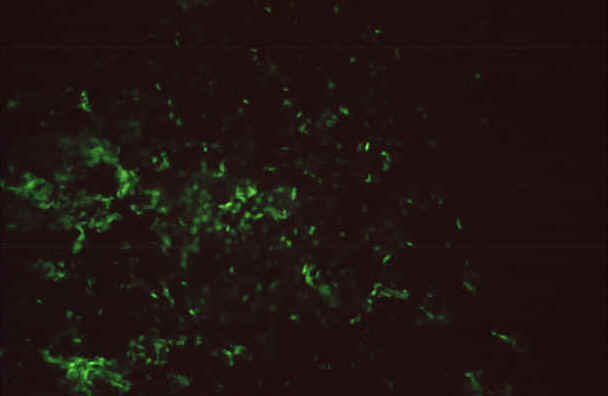
IFA reaction of a positive human serum on Rickettsia rickettsii grown in chicken yolk sacs, 400X
Photo and text courtesy of the CDC - http://www.cdc.gov/ncidod/dvrd/rmsf/Laboratory.htm
There are four main methods by which R. rickettsii are thought to evade detection by their host’s immune system. The first method involves R. rickettsii activating the NFkB mechanism in order to inhibit apoptosis. (Walker et al., 2003) Infection of the endothelial cells by Rickettsia rickettsii result in the activation of the transcription factors of the NFkB pathway. This molecules a ubiquitous transcription factor that expresses many early response genes, and often readily responds to its environment. R.rickettsii-induced expression of certain endothelial cell genes results in the loss of many endothelial cells. NFkB activation is thought to play a critical role in the protection of cells from apoptosis induced by tumor necrosis factor alpha, radiation, and treatment with chemotherapeutic drugs. However, the specific nature of the signaling mechanism that results in the induction of apoptosis is still not known. It is speculated that the induced death signal probably requires the bacteria to be present intracellularly, could involve the production of various oxidants, or could require an interaction with one or more of the multiple regulatory host cell molecules involved in the induction of apoptosis. (Clifton et al., 1998) This evolutionary mechanism is extremely beneficial to the Rickettsia rickettsii because intracellular bacteria grow so slowly and require multiple days in order to successfully replicate within a host cell. Therefore, by inhibiting host cell apoptosis, the pathogen experiences prolonged growth and survival of its offspring. However, this inhibition is not permanent and the host does eventually regain its ability to induce programmed cell death in the area infected by the pathogen. (Walker et al., 2003)
The second method by which the pathogen evades the immune system involves its escape from the phagosome. The bacteria avoid the attack of this destruction mechanism by lysing the membrane of the phagosome and preventing the fusion with and any contact with lysosomes (which would essentially destroy and digest the pathogen). (Walker et al., 2003) In a study of Rickettsia conorii, this mechanism was so effective that the bacteria were rarely observed to be located in a closed phagocytic vacuole. The process by which these bacteria avoided destruction by the phagosome was a very rapid procedure and over 90 percent of the bacteria were able internalize into the host cytosol. Evidence for this phenomenon has been shown by the fact that drugs that block phagocytosis also inhibit the entry of rickettsiae. (Teysseire et al., 1994)
The third mechanism involves the selection for IFN-gamma resistance. (Walker et al., 2003) In normal rickettsiae infections, IFN-gamma directly inhibits the growth of the bacteria in fibroblasts and macrophages, playing an important role in the initial response to infection. Experiments with R. prowazekii have shown the ability of the bacterial strains to develop a resistance to this defense mechanism. Four different isolates of this strain have already been purified. These strains were resistant not only to IFN-gamma, but to IFN-alpha and IFN-beta as well. The ability of rickettsiae species to evolve/select for this type of mutation could result in a variety of problems in treating future strains. (Turko et al., 1990)
Finally, the last mechanism that allows it to avoid the immune system is through its rapid spread among cells within the host cell. (Walker et al., 2003) The cell carries out this mechanism through actin-based mobility (ABM) which enables the pathogen to move extremely quickly throughout the cytoplasm at a rate of about 4.8 um/min. In addition, their actin filaments that provide this movement are very stable (exhibited a long half life). The actin tail associated with intracytoplasmic rickettsiae remains still as the organism is propelled foward, whereas those bacteria in the nucleus displayed much more rapid movements. The pathogen's ability to move throughout the cytoplasm is suggested to be linked to its virulence. (Heinzen et al., 1999)
One additional, speculative mechanism in which the pathogen evades the immune system is through latency, especially in the lymph nodes. This case is relatively rare in R. rickettsii, but it has been reported in a few other similar species. (Walker et al., 2003)